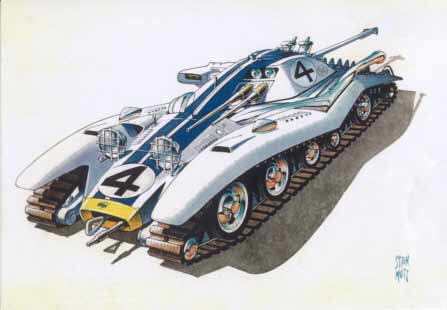Awesome WWI Tank Downloadable Collection from Fiddlersgreen
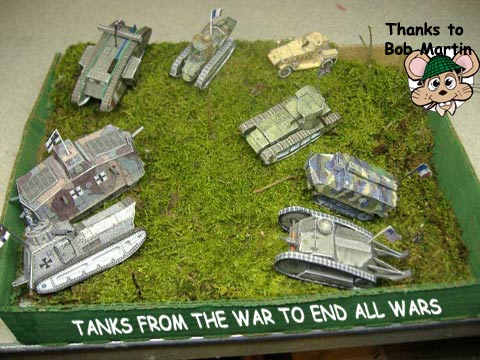 If anyone were to call Leonardo da Vinci an "armament maker" and a "military theoretician" .. he would certainly encounter massive, indignant criticism. But he would be quite right, nonetheless. First of all, he could point to the close connection between scientific research and military applications in the Middle Ages and take Leonardo's case as proof of how scholars, researchers and inventors of that time boasted of the advantages of their discoveries for military purposes If anyone were to call Leonardo da Vinci an "armament maker" and a "military theoretician" .. he would certainly encounter massive, indignant criticism. But he would be quite right, nonetheless. First of all, he could point to the close connection between scientific research and military applications in the Middle Ages and take Leonardo's case as proof of how scholars, researchers and inventors of that time boasted of the advantages of their discoveries for military purposes"I shall also build safe, covered chariots that cannot be attacked, which, when they penetrate the enemy with their artillery, force even the greatest host of armed men to break. The infantry can follow in their wake with little risk and no resistance." Duke of Milan,- 1484, we find the origin of the tactics of mobile armored warfare. Later,,this was to decide the outcome of two world wars. |
.
"Thanks, the tank series is a hoot. Tanks are usually a pain in the tookus, what with all the bogies, etc...This set, well, sets a new bar...Easier to build with enough detail to be satisfying... Ya just can't beat a good FG..." -Wayne White
"Thanks for the tanks." -Michael 2011
"Spot on WWI tanks... I love it!" -Jack G.
"Top notch tank collection. Easy enough to build and amazingly well created designs. I have a new hobby thanks to you, Fiddlersgreen rocks." -Harry S.
"My gaming buddies and I love 'em." -Fred Wilson
"You are absolutely right: they ARE awesome." -Robert B.
Awesome WWI Tank Collection
|
Since all the cultivated men of that day, including writers and artists, followed with the greatest attention every advance in the natural sciences, the newly discovered laws of physics made an immediate impact in other fields.
Albrecht Durer busied himself with the study of military problems, first and foremost fortifications. When the Emperor Maximilian I made an alliance with King Henry VI of England against the French in 1512, Durer designed a number of combat vehicles for the Imperial army. He applied the law of the lever and invented various new systems of power transmission. Instead of being drawn by horses, his combat vehicles were driven by hand or foot power, and the crew used not only cranks and pedals but push rods as well to move their cars. The Emperor, though very open to all new ideas, did not take Durer's technical suggestions too seriously and so not even a "prototype" was actually built.
Only English horse drawn cars were used at Guinegate and Flodden Field, where the French and their Scottish allies were defeated. The next step towards a combat vehicle not drawn by horses was the "mobile bulwark" designed by the Nuremberg master craftsman Berthold Holzschuher, which not only possessed armor plating to protect the crew against enemy weapons and a device for hurling boiling oil and burning pitch, but was also equipped with the first known "four-wheel drive". Each wheel was manned by two stout men, who drove the massive vehicle by cranking them with all their might and main.
Holzschuher's design (right) found many imitators. His fellow-citizen, the master craftsman Hans Hautsch, proved that good publicity served to make a new combat vehicle known and
|
helped its inventor to achieve recognition and wealth. This is what was written about Hautsch's vehicle and his promotional ability: "However, a third citizen of Nuremberg, the
Sixteenth century assault 'Barn-Like' vehicle. |
clever wheelwright Hans Hautsch, won real fame in this field. In 1649 he amazed his fellow townsmen with a 'Triumphal Car' that ran over the bumpy roads as if driven by a ghost. Master Hautsch sat proudly at the tiller, that was clear to see. But what one did not see was the powerful fellows who kneeled inside the body of the vehicle and strenuously turned the driving crank. It was the first vehicle with a signaling system and what a drastic one it was. A dragon's head set firmly on the bow spewed water on any inquisitive spectators who blocked the road and so cleared the way for the driver."
It would not be too far-fetched to say that combat vehicle construction was in the doldrums. In fact it is not until over a century later that we find the description of an overland vehicle that displayed all the features of an assault gun while still relying on men's muscles for driving power. "The two men standing in front are the master gunners who load and fire the gun. The man seated behind them is the aimer who steers the vehicle with the help of ropes connected with the rotatably-mounted front axle, and so aims the gun at the chosen target. The fourth and last crewman has the task of setting the whole vehicle in motion by turning a crank that acts on the rear axle through a cog-wheel gear."
|
Given such an unsatisfactory driving system, it is no wonder that every effort was made to find other ways of moving machines whose weight was increasing steadily. The amphibious vehicle (right) invented by the Italian Agostino Ramelli in 1588 was drawn by a horse on land and propelled by hand-driven paddle wheels on water. But even this innovation could not eliminate the major drawback of all such combat vehicles, namely the discrepancy between the weight and volume of the vehicle and the human or animal power available. Even the sail, which had long been used to advantage at sea, proved useless when it came to propelling vehicles on land. A structural sketch dating from 1600 shows a wagon that was identical with contemporary sailing vessels right down to the smallest detail. But there is no evidence that it ever saw action.
Another land ship that was designed to utilize wind power and also the latest technical advances was the wind power car. It had no sail but in its place windmill vanes at each side, whose rotary motion was transmitted to all four wheels by a cogwheel gear. Several specimens of this vehicle were actually built and employed on various occasions. But their scope was limited by the fact that they could only travel over dry, flat ground and only when the wind was blowing towards the enemy-upon which a tactician could not always count. Nonetheless a certain number of land ships are recorded in documents at the beginning of the modern era. In 1599 Simon Stevin built a vehicle of this type for Prince Maurice of Nassau. It had a crew of 29 and a speed of 7 miles an hour with a favorable wind. In England a certain David Ramsay was granted a patent in 1634 for a self-propelled wagon that was also designed for military use.
After all these disappointing experiments a turning point seems to have been reached at last in the mid-eighteenth century, with the discovery of a new source of power
|
constituted by the combined use of two elements that had long been known-fire and water. In 1765 James Watt succeeded in putting steam to practical use, and that marked a new stage in the development of military science. Four years later, in 1769, the Frenchman Joseph Cugnot set a steam engine on a wheeled chassis, which thus became self-propelling. The next year he demonstrated the machine to the French ambassador to the Austrian court. But its maximum speed was only about 2 miles an hour and it had to stop for a quarter of an hour every 12-15 minutes to build up pressure. Today we are inclined to think that to have got a machine to move at all by artificial means at that period in history was a considerable achievement, but people then were less longsighted and Cugnot's demonstration was considered a failure. When Bonaparte, as a famous general, was elected to the French Academy he wrote a treatise on the military utilization of steam-driven combat vehicles, thus demonstrating his foresight in the domain of weaponry and armor.
In England too the discovery of the new source of power spurred inventors and designers to further efforts. In 1852, under the heading "Smith's Mobile Battery", the Leipziger Illustrierte Zeitung described the first combat vehicle that could offer protection against artillery, which was already highly developed at that time. "It is a small battery of one gun designed to move on ordinary roads. The plan, which was brought out by a certain Mr Smith of Drosford, England, involves building it of iron sufficiently thick to resist the shots of the artillery that accompanies normal armies on the march. It forms a dome measuring 24 feet in length, 16 in breadth and 12 in height. These proportions, it is claimed, will allow the battery to move without difficulty up and down highways, which under English law must be at least 30 feet wide. In addition, the battery should, according to plan, be propelled by a steam engine that closely resembles 'Bray's Traction Engine'."
|
Smith was well aware of the drawbacks of his mobile fortress. This is proved by his idea of fitting directly under the front axle a massive cylinder equal in length to the entire width of the machine, whose weight it would support if the wheels happened to encounter soft ground. The armament of Smith's battery comprised 12 breechloaders and a pivoting gun that could turn through 360 degrees and fire in any direction. What new strategic and tactical problems the design of a vehicle raised is shown by the following sentence in the German newspaper's description: "The Englishman thinks he is in a position to build a battery whose weight, including crew, armament and ammunition, is not in excess of that which normal bridges and roads can carry."
Steam was far more successful as motive power for ships and railway stock. So much so that only a few years after the steam engine started out on its triumphal march the first ironclad fighting ships appeared on the high seas and the first armored trains on the battlefields. We find armored trains during the American Civil War; accompanying the advance of the white settlers on the American continent; at the siege of Paris in 1871; in the Boer War and the Sudan campaign. They were composed of engines and wagons protected with heavy armor plates and equipped with cannon and machine guns. The first steam-powered land vehicle not rail bound that was ever employed in war was a three-wheeler. The boiler was suspended between the two rear wheels and the single, larger front wheel. The cannon was mounted on one side. This armored vehicle had no steering gear and could only move in one direction. It was used shortly before the French Revolution.
In the long run even the invention of the steam engine did not result in any real progress in the armored-vehicle field. Owing to the enormous weight of the ironclad monsters the friction between wheels and ground consumed a large fraction of the available power. But bigger and therefore more powerful engines required larger quantities of "fuel", namely coal and water, so that the actual useful load remained extremely low. The vital problem was to reduce the ratio of engine power to vehicle weight: it is still one of the toughest problems in tank construction.
It was not long, however, before new technological advances occurred. In 1876, over a
|
century after Joseph Cugnot's efforts, Nikolaus Otto presented the first four stroke compression engine, and Carl Benz built his first automobile in 1885. That would
|
have never sufficed to bring about the actual breakthrough in armored-vehicle construction were it not for the appearance of another revolutionary factor at about the same time. Namely, the development of what a Germany military paper written in 1880 termed an "absolutely novel transport system by means of an endless iron track". The internal combustion engine and the caterpillar track are still the major structural features of the tank that shaped the image of two world wars and offers newly discovered advantages in the nuclear age. The first mention of a caterpillar track dates back to the year 1825, when it seems to have been invented by a German named Krauterer.
The mid-nineteenth century saw the appearance of steam tractors, which had lateral booms equipped with "feet and wheels" in order to spread over a larger surface the enormous pressure they exerted on the ground and so reduce its specific value. They were employed during the Crimean War of 1854/55. But it was only in the Franco-Prussian War of 1870 that the military establishment realized the necessity of giving artillery and other heavy equipment cross-country capability by fitting them with a suitable undercarriage. Julius Schneider, a German sapper born in Silesia in 1840, who gave much thought to this matter, wrote an essay entitled "On the Construction of Transport Wagons with Toothed Wheels on an Endless Tread", which was published in the Archive for Artillery and Engineer Officers of the German Imperial Army in 1872. He himself built small-scale demonstration models and wrote an explanatory note entitled "Track without End" . Schneider was balked in his request for permission to dedicate this paper to the Emperor, who was his Commander-in-Chief. The embittered young captain recorded in his diary: "Doubts about the design of the car have been expressed on many sides and it has been described by high-ranking superior officers as not worth a practical trial. The idea
|
The first motorized combat vehicles were developed simultaneously with these first trials with the "endless track" as the caterpillar track was then called. At the start, however, the design of armored cars for combat and reconnaissance was based on the four-wheel automobile. A long time passed before both paths converged and the motorized military vehicle was combined with the caterpillar-track chassis.
The first armed motor vehicle was designed by Colonel R.P. Davidson of the Illinois National Guard, who was a lecturer at the North-Western Military Academy. In 1889 he entrusted the task of building it to Charles E. Duryea, who had already built a petrol-engined passenger car. This first "motor gun car" was a three-wheeler armed with a machine gun and protected in front by a steel shield. It carried four men including the driver. Subsequently, the same design was adapted to a four-wheel chassis. Shortly after this the Academy commissioned two steam-powered four-wheel combat cars that were also equipped with a machine gun and light armor
|
plating. This enabled the cadets to obtain experience in the first motorized unit in the history of war. But the importance of the new weapon was far from being recognized at the time.
During that same period in England a man called Pennington was attracting a great deal of publicity to himself and his invention. In November 1896 he presented plans for a four-wheel armored car with two machine guns, which he had allegedly been commissioned to build by a British syndicate. The international press seems to have taken Pennington's announcements more seriously than he did himself. It is true, however, that he made the public on both sides of the English Channel conscious of the potentialities of the armored car. Moreover, his plans displayed a number of features that look extremely modern. For instance, the wheels were mounted under the armor, the sides of the car were smooth and canted to make missiles glance off more easily and the car presented the "tortoise silhouette" still typical of the modern tank.
In 1899 F.R. Simms, a British engineer, presented a Maxim gun mounted behind a steel shield on a four wheel chassis. He gives the impression of having been far more serious than Pennington but met with less success. The "Motor Scout", as he called his machine, was driven by a number of people but the military would have nothing to do with it. The same is true of a 6-ton vehicle with boat shaped armor plating designed by Simms
|
and built by a British firm in 1902. By . that time, however, the armored car was so much talked of at the international level that competition between the Great Powers ensured its technical development.
In the very year that Simms attempted in vain to have his 6-ton vehicle adopted by the British armed forces, development started on the Continent on a vehicle that not long after was presented as the fi.rst fully armored overland reconnaissance car. From 1903 to 1905 the Daimler Motor Company at Wiener Neustadt realized their own plans, which subsequently proved to be the real breakthrough in armored cat; design. They embodied the principles of the modern armored reconnaissance car-four-wheel drive, revolving turret fitted with machine gun or light cannon and drop-seats for commander and gunners, who were thus able to avoid enemy fire by ducking down behind the armor plating. The vehicle, which weighed only two tons, was powered by a 30 h.p. AustroDaimler four-cylinder four-stroke carburetor engine. It could withstand shrapnel and rifle fire up to a distance of about 350 yards. Thus it satisfied one of the demands of modern tanks: the enemy infantry were within range of its guns before they could attack it effectively. Although four-wheel drive was already known, it
|
constituted the real technical novelty of the car. In 1905 Austro- Daimler patented their four-wheel drive, which was the final solution of two technical problems. First, the guide wheels were driven without the insertion of joints, which are very much subject to failure; secondly, the greatest power was applied direct to the working wheels so that all the other parts of the transmission could be kept weaker and therefore substantially lighter. The cupola of the armored turret could be rotated by a hand crank through 360 degrees, enabling the commander to concentrate on his task, whether combat or observation, independently of the direction in which the vehicle was traveling. This armored reconnaissance car held a crew of four or five and also had room for the necessary ammunition. Its top speed on a straight road was under 30 miles an hour.
When the Daimler armored car was employed in the Austrian Imperial maneuvers of 1906 it caused a twofold surprise. The report
|
on the exercise says that enemy patrols were so astonished by the appearance of the armored car that they were completely paralyzed. As a result the car crew were able to drive unhindered so close to the enemy's positions that they could find out all about his troops. The car's success in this its first mission was capped by the part it played in the capture of a Major General commanding an enemy brigade.
A report on the maneuvers of 1910 records an event which was to have a major impact on the future of the armored car as equipment for the German and Austrian armies: "The Austrian autumn maneuvers took an unexpected turn. A young lieutenant, Count Sch6nfeldt, completely ruined the whole concept when he took advantage of the permission he had been granted to present the armored car he and Paul Daimler had built.
The Emperor and his Generals were observing the course of the battle from a low hill. They were dismayed by messages informing them that the enemy's armored car had entered a well fortified village unhindered and even carried out a reconnaissance because evidently its appearance had been a total surprise. Such a thing was unheard of and broke all the rules of the war game. However, it gave the more thoughtful officers matter for meditation: they asked themselves whether the crazy machine might not in the last analysis be a useful instrument of war. There is no saying what might have happened in the next war if the decision had been taken to develop the new weapon and use armored regiments in place of cavalry, which is no less delicate than decorative. But the decision was left to the horses themselves. When the young lieutenant drove past the Generals' knoll in his puffing, clanking, smoke-belching vehicle, the highborn chargers on which the noble, gold-belted assembly were
|
watching the maneuver began to tremble. The Emperor's gentle mount even attempted to bolt. That was the end of the new weapon ... "
The Germans too overlooked the potentialities of the armored car, whose importance was not realized until well into the first world war, which broke out a few years later. This is what General Guderian, the famous German tank commander, has to say about the fatal sins of omission and erroneous judgments for which the German military establishment was responsible: "Trials were made with armored cars as early as the year 1909
|
Two French armored cars reached Eydtkunen by train on their way to Russia. The Russians did not take them over, so they were purchased by Germany. They took part in a maneuver of the 5th Brigade of Foot Guards with other motor vehicles. A report says: 'The armored cars can cover long distances very fast but have to keep to metalled roads. The speed-I5 miles an hour-was too high and often had to be reduced to 4-8 miles an hour.' Although the Research Branch of the Transport Corps Inspectorate wanted to proceed with the construction of an armored car, the War Ministry decided on March 12, 1910, to desist from further experiments. It was considered that their field of application was very restricted: armored cars could only improve.
|
In 1456 the Scots invented a timber wagon that had room for the draught horses as well as the crew; but at the start the former had no protection and in consequence were very vulnerable. Later, the under part of the wagon was timbered too, so that the horses were protected, but it made the vehicle very difficult to steer. The battle wagon reproduced in the war book written by a knight named Ludwig von Eyb was an improvement on the Scottish vehicle but may have been an original design based on ancient models. Though dated about 1500 it was mounted on thick disc wheels, which were almost completely obsolete at the time. On the other hand, von Eyb's sketch gives the idea of an almost modern profile with a ramming spur in front and loopholes at the sides. It also gives the first indication that combat vehicles were camouflaged with leaves and branches to conceal them from the enemy until the attack was launched. About 1558 Master Bertold Holzschuher of Nuremberg designed an assault car that bears an astonishing resemblance to the British "Willies" of World War 1. But it displayed the same defects as its predecessors of Antiquity and the Middle Ages. The "armor" had necessarily to be strengthened in order to stand up to the increasing efficiency of throwing- and firearms; this made the vehicles more cumbersome. Ever since the introduction of combat vehicles, efforts had been made to combine the three factors armor, fire power and mobility to obtain the best results. Such clever inventors as Leonardo da
Vinci, Ludwig von Eyb and Bertold Holzschuher may have guessed that a really practical combat vehicle could never exist so long as it depended on the horse for its motive power. In fact, the combat vehicle of modern times, namely the tank, was
only developed when mechanical propulsion became feasible.
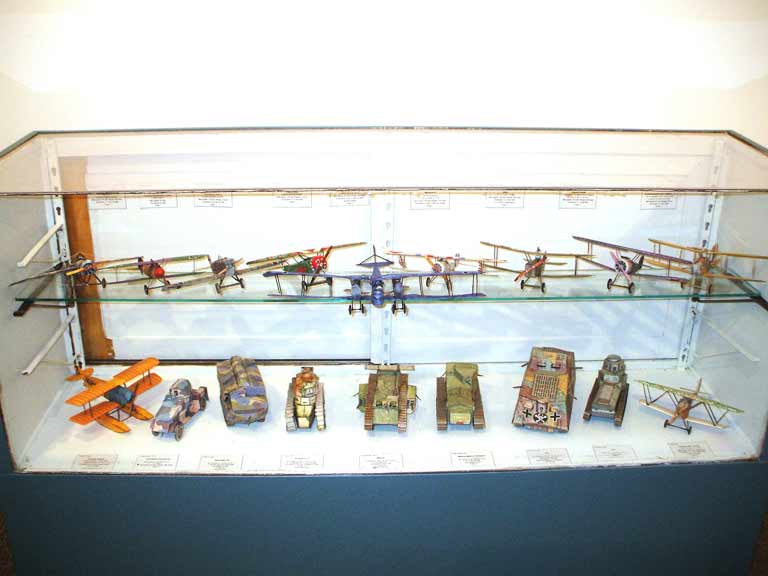 |
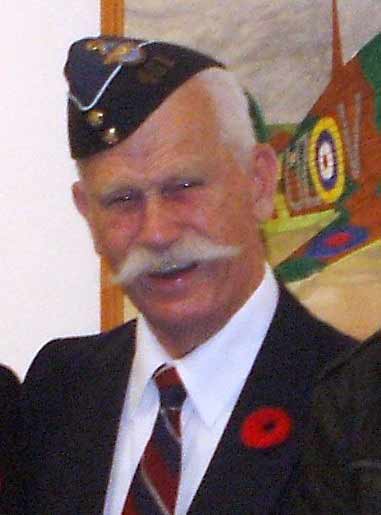 |
Hi Chip, I opened an exhibition of my WWII aircraft paintings yesterday, in the exhibit hall I used a showcase, which I filled with aircraft and tanks from WWI. Here in Canada we celebrate ''Remembrance Day" tomorrow 11 November. The showcase was a great success, it made me very happy. I put a label explaining that the models came from Fiddlersgreen.. Thanks Chip! -Lars E. Lindgren |
|
A listing of all the Fiddlersgreen WWI Tanks
A7V Tank |
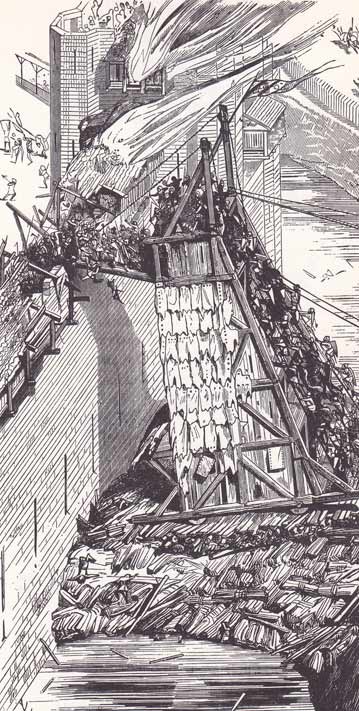 This battle tower crosses the moat before standing face-to-face with the castle wall and tons of swarming defenders |
Ford M1918 Designed in 1918 by Ford Motor Corp it was intended as a quick and easy substitute to the Renault FT-17. 15,000 were ordered but only fifteen were actually produced and then only two were shipped to France for battle before the 'war to end all wars'...ended. This 3 ton light WWI tank, about as heavy as an SUV, was powered by two off-the-shelf model T engines. |
|
Lanchester Armored Car In 1914, the Lanchester was the second most numerous armoured car in service after the Rolls-Royce. It was originally designed to support air bases and retrieve downed pilots. In 1915, the Lanchester underwent hull remodeling and was formed into armoured car squadrons. This model has a fun Bush/Cheney version included. |
|
LKII Tank The LK-II was a late WWI German tank that, in fact, was late for the Great War to End all Wars And just a little too early for the next one war. The folder has a larger version (1:22 and a smaller at 1:36. Now all the WWI tanks in this in your folder have been updated to be in relative matching scales so you can display them as a set. Always print from your MyModels folder |
|
Mark IV A classic looking 1917-18 British Tank which was arguably, the most important tank in the 'War to End All Wars". Comes in British, captured German, and BW and two sizes. An easy and especially fun build.. Approx scales 1:54 and 1:39 |
|
Renault FT17 Renault FT-17 WWI light tank.. This was the first real armored WWI Tank and was used by many countries all the way into WWII. Comes in THREE versions. two sizes plus a BW for war gamers Reduce to any scale. Also included is a cardmodel diorama ruins. |
|
Schneider Tank |
|
St. Chamond |
|
Whippet The Whippet "A" was the first medium tank to enter service in WWI. It was the first tank with a separate turret displaying the classic silhouette that we still see in present day tanks. It's successes in 1918 made the tacticians sit up and take notice of the medium tank concept. Comes in British and German(captured) markings. Large and regular sizes plus handy BW. Great informative instructions !! |
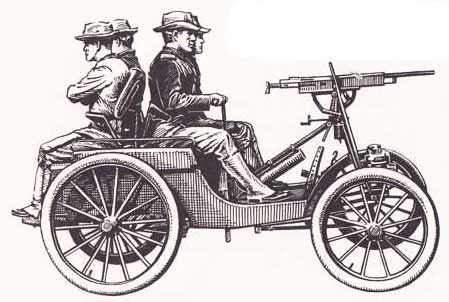 The first "motor gun car." It was steam driven and carried a machine gun with a steel front shield for protection. The first "motor gun car." It was steam driven and carried a machine gun with a steel front shield for protection. |
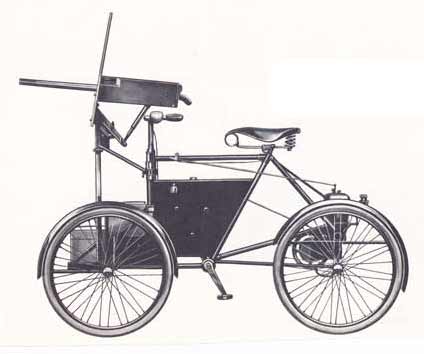 A Four-wheel vehicle equipped with a machine gun and shield. A Four-wheel vehicle equipped with a machine gun and shield. |
Images of fantasy tanks pulled from the web
|
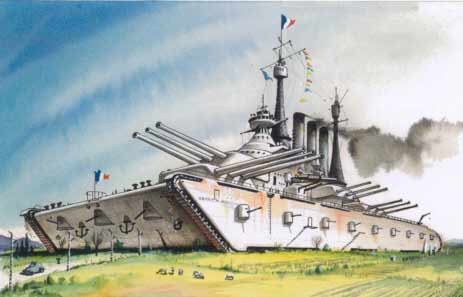 |
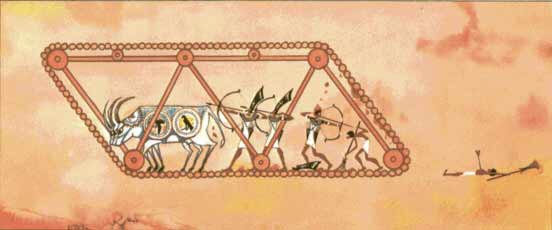 Imaginative Ancient Egyptian tank (pure fantasy). |
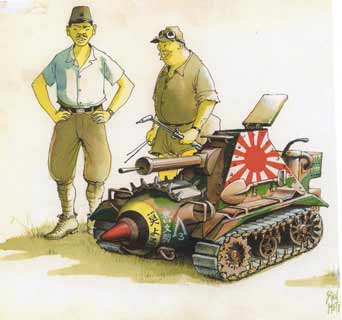 |


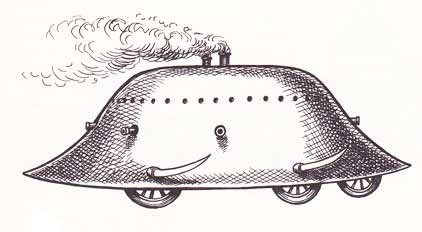 The steam engine did little to promote the development of the tank. The power created by the engine was consumed by its own weight.
The steam engine did little to promote the development of the tank. The power created by the engine was consumed by its own weight.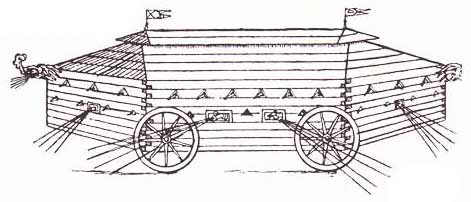 This combat vehicle was to have been driven by horses hidden inside, however it was too heavy for combat.
This combat vehicle was to have been driven by horses hidden inside, however it was too heavy for combat.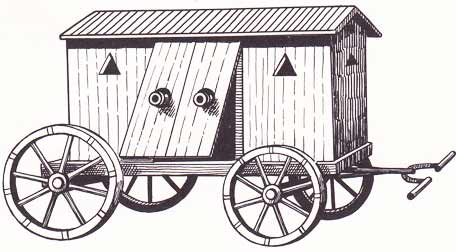
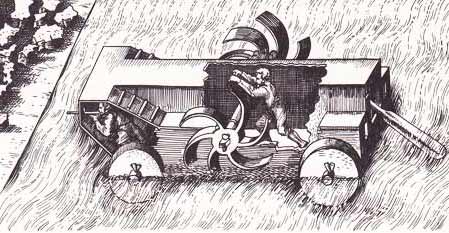 Since the sixteenth century inventors have tangled with the idea of an amphibious combat vehicle that could navigate deep water thanks to two helical wheels.
Since the sixteenth century inventors have tangled with the idea of an amphibious combat vehicle that could navigate deep water thanks to two helical wheels.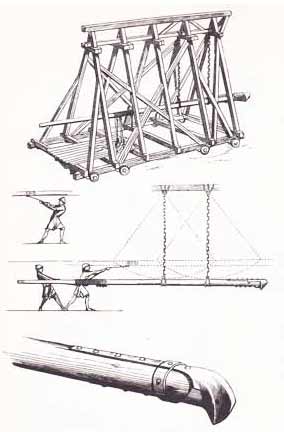 The mobile battering ram was usually cloaked with timber or hide to protect the crew. The iron-tipped ramming beam hung from chains that were swung.
The mobile battering ram was usually cloaked with timber or hide to protect the crew. The iron-tipped ramming beam hung from chains that were swung.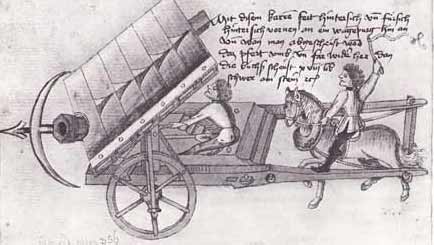 This vehicle could move forwards and backwards. Its cannon was protected by an iron plate and scythe. A wooden shield protected against arrows.
This vehicle could move forwards and backwards. Its cannon was protected by an iron plate and scythe. A wooden shield protected against arrows.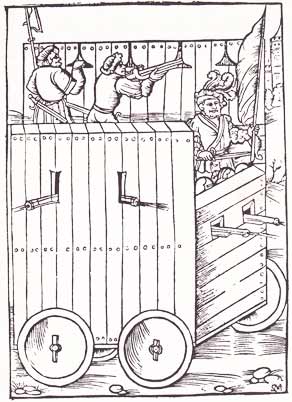 This armored gun chariot designed circa 1500 was propelled forward by men on the inside.
This armored gun chariot designed circa 1500 was propelled forward by men on the inside.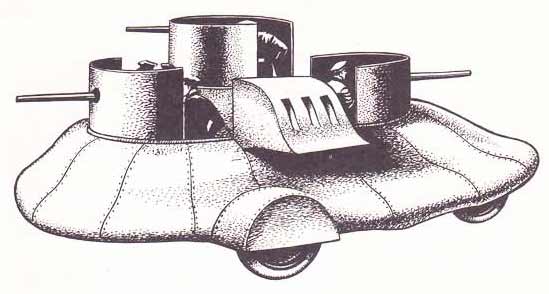 Designed in 1902.
Designed in 1902.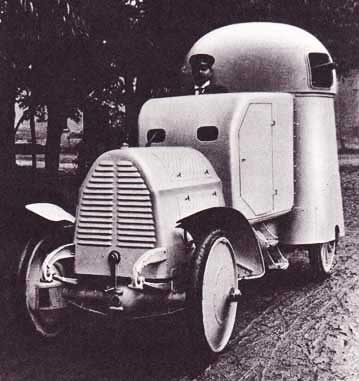 The Austro-Daimler set the trail for other armored car designers around the world.
The Austro-Daimler set the trail for other armored car designers around the world.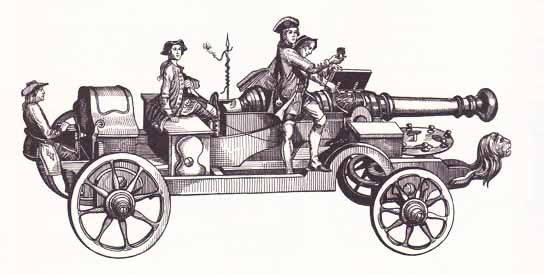 This eighteenth century combat vehicle featured all that an "assault gun" would entail and was man powered with a hand crank.
This eighteenth century combat vehicle featured all that an "assault gun" would entail and was man powered with a hand crank.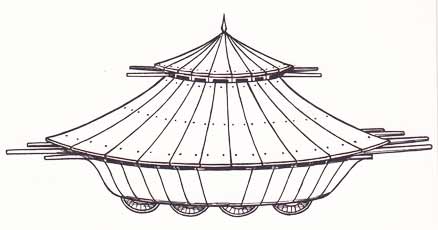 "I shall build safe, covered chariots that cannot be attacked, which, when they penetrate the enemy with their artillery, force even the greatest host of armed men to break." Leonardo da Vinci
"I shall build safe, covered chariots that cannot be attacked, which, when they penetrate the enemy with their artillery, force even the greatest host of armed men to break." Leonardo da Vinci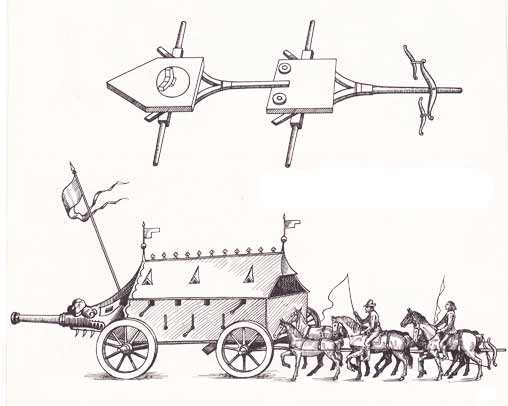 An early steered combat vehicle of the sixteenth century.
An early steered combat vehicle of the sixteenth century.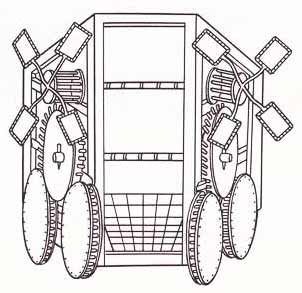 A four-wheel drive wind-chariot... only operational when the enemy is down-wind.
A four-wheel drive wind-chariot... only operational when the enemy is down-wind.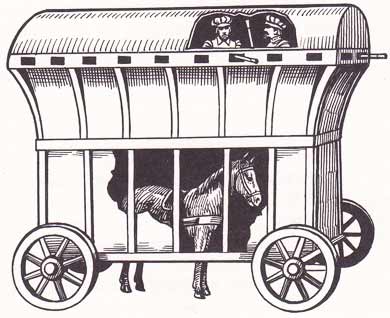 Early tanks were powered by horses.
Early tanks were powered by horses.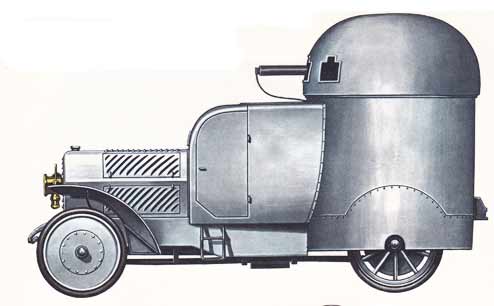 An armored car incorporating the major principles of today: four-wheel drive, revolving turret with gun, and a crew of specialists.
An armored car incorporating the major principles of today: four-wheel drive, revolving turret with gun, and a crew of specialists.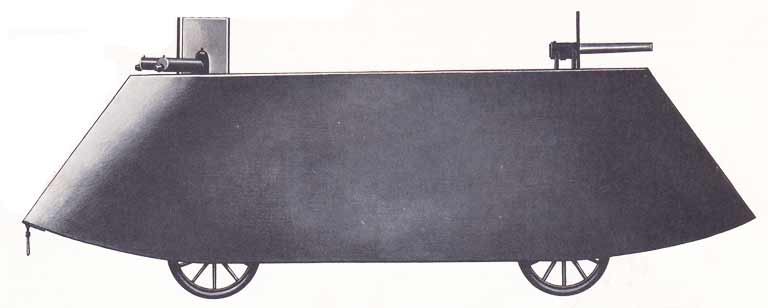 The first heavy armored car with steel plating. The "war motor car" was designed as both an offensive and defensive weapon.
The first heavy armored car with steel plating. The "war motor car" was designed as both an offensive and defensive weapon.